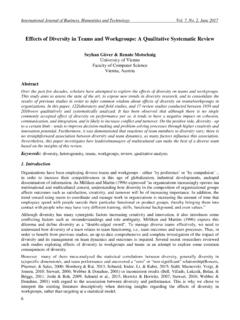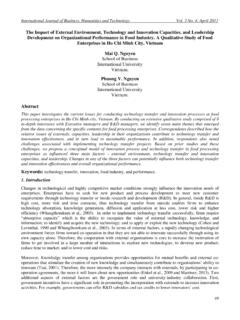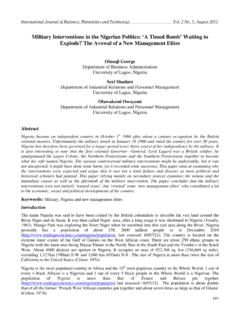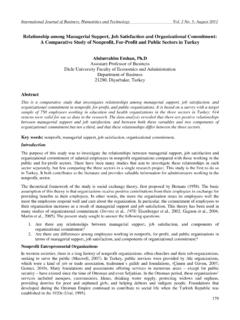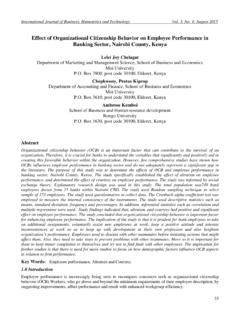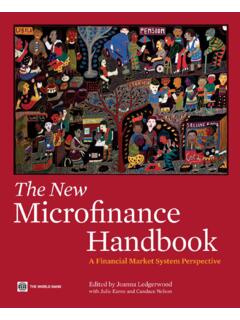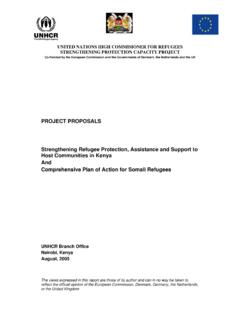Transcription of Effectiveness of Credit Management System on Loan ...
1 International Journal of Business, Humanities and Technology Vol. 2 No. 6; October 2012 99 Effectiveness of Credit Management System on Loan Performance: Empirical Evidence from Micro Finance Sector in Kenya Haron O. Moti Public Procurement Oversight Authority Box 58535-00200 Nairobi, Kenya Justo Simiyu Masinde Lecturer in Finance Chuka University College Kenya Nebat Galo Mugenda Lecturer in Finance Chuka University College Kenya Mary Nelima Sindani PhD Student Jomo Kenyatta University of Agriculture and Technology Kenya Abstract Microfinance institutions in Kenya experience high levels of non-performing loans. This trend threatens viability and sustainability of MFIs and hinders the achievement of their goals. This study was aimed at assessing the Effectiveness of Credit Management systems on loan performance of microfinance institutions. Specifically we sought to establish the effect of Credit terms, client appraisal, Credit risk control measures and Credit collection policies on loan performance.
2 We adopted a descriptive research design. The respondents were the Credit officers of the MFIs in Meru town. Collection policy was found to have a higher effect on loan repayment with = , P= at 5% significance level. Further research is recommended on the Effectiveness of Credit referencing on loan performance of MFIs. This study is informative in terms of public policy adjustments and firm level competences required for better operation of MFIs and it also contributes to Credit Management literature. Key Words: Credit Management System , Loan Performance, Loan Performance, Index Microfinance 1. Introduction Background of the study The concept of Credit can be traced back in history and it was not appreciated until and after the Second World War when it was largely appreciated in Europe and later to Africa (Kiiru, 2004). Banks in USA gave Credit to customers with high interest rates which sometimes discouraged borrowers hence the concept of Credit didn t become popular until the economic boom in USA in 1885 when the banks had excess liquidity and wanted to lend the excess cash (Ditcher, 2003).
3 In Africa the concept of Credit was largely appreciated in the 50 s when most banks started opening the Credit sections and departments to give loans to white settlers. In Kenya Credit was initially given to the rich people and big companies and was not popular to the poor. In 1990s loans given to customers did not perform which called for an intervention. Most suggestions were for the evaluation of customer s ability to repay the loan, but this didn t work as loan defaults continued (Modurch, 1999). The concept of Credit Management became widely appreciated by Microfinance Institutions (MFI s) in the late 90s, but again this did not stop loan defaults to this date (Modurch, 1999). Centre for Promoting Ideas, USA 100 A key requirement for effective Credit Management is the ability to intelligently and efficiently manage customer Credit lines.
4 In order to minimize exposure to bad debt, over-reserving and bankruptcies, companies must have greater insight into customer financial strength, Credit score history and changing payment patterns. The ability to penetrate new markets and customers hinges on the ability to quickly and easily make well-informed Credit decisions and set appropriate lines of Credit . Credit Management starts with the sale and does not stop until the full and final payment has been received. It is as important as part of the deal as closing the sale. In fact, a sale is technically not a sale until the money has been collected. It may be difficult to establish an optimal Credit policy as the best combination of the variables of Credit policy is quite difficult to obtain. A firm will change one or two variables at a time and observe the effect. It should be noted that the firm s Credit policy is greatly influenced by economic conditions (Pandey, 2008).
5 As economic conditions change, the Credit policy of the firm may also change. Microfinance Institutions and other finance institutions must develop a Credit policy to govern their Credit Management operations (Pandey, 2008) and since microfinance institutions generate their revenue from Credit extended to low income individuals in the form of interest charged on the funds granted (Central Bank Annual Report, 2010) the loan repayments may be uncertain. The success of lending out Credit depends on the methodology applied to evaluate and to award the Credit (Ditcher, 2003) and therefore the Credit decision should be based on a thorough evaluation of the risk conditions of the lending and the characteristics of the borrower. Numerous approaches have been developed in client appraisal process by financial institutions. They range from relatively simple methods, such as the use of subjective or informal approaches, to fairly complex ones, such as the use of computerized simulation models (Horne, 2007).
6 Many lending decisions by Microfinance institutions are frequently based on their subjective feelings about the risk in relation to expected repayment by the borrower. Microfinance institutions commonly use this approach because it is both simple and inexpensive. While each company would have its own method of determining risk and quality of its clients, depending on the target group , the following client evaluation concepts are useful for most occasions. These concepts are referred to as the 5C s of Credit appraisal (Edward, 1997). These elements are Character, Capacity, Collateral, Capital and Condition (Edward, 1997). Statement of the Problem The success of MFIs largely depend on the Effectiveness of their Credit Management systems because these institutions generate most of their income from interest earned on loans extended to small and medium entrepreneurs. The Central Bank Annual Supervision Report, 2010 indicated high incidence of Credit risk reflected in the rising levels of non- performing loans by the MFI s in the last 10 years, a situation that has adversely impacted on their profitability.
7 This trend not only threatens the viability and sustainability of the MFI s but also hinders the achievement of the goals for which they were intended which are to provide Credit to the rural unbanked population and bridge the financing gap in the mainstream financial sector. A Study on microfinance Credit recovery systems is a topic of considerable interest by many researchers. However, most studies undertaken in the past few years have focused mainly on Credit models used by MFI s and their impact on profitability (Migiri, 2002). Absence of empirical studies on Credit recovery systems and recognition of the critical role that MFI s play in the economy are the principal motivation behind this study which sought to find out the Effectiveness of Credit Management systems on loan performance among microfinance institutions. Objectives The overall objective of the study was to assess the Effectiveness of Credit Management systems on loan performance in microfinance institutions.
8 Specific Objectives i. To establish the effect of Credit terms of microfinance institutions on their loan performance. ii. To determine the effect of client appraisal on loan performance of microfinance institutions. iii. To evaluate the effect of Credit risk controls measures adopted by microfinance institutions on their loan performance. iv. To evaluate the effect of Credit collection policies on loan performance of microfinance institutions. International Journal of Business, Humanities and Technology Vol. 2 No. 6; October 2012 101 Hypotheses The following hypotheses were developed for empirical testing: H01: There is no significant relationship between Credit terms and loan performance of microfinance institutions. H02: There is no significant relationship between client appraisal and loan performance of microfinance institutions. H03: There is no significant relationship between the Credit risk control and loan performance of microfinance institutions.
9 H04: There is no significant relationship between Credit collection policies and loan performance of microfinance institutions. 2. Review of Literature The 5 C s Model of Client Appraisal Microfinance Institutions use the 5Cs model of Credit to evaluate a customer as a potential borrower (Abedi, 2000). The 5Cs help MFIs to increase loan performance, as they get to know their customers better. These 5Cs are: character, capacity, collateral, capital and condition. Character basically is a tool that provides weighting values for various characteristics of a Credit applicant and the total weighted score of the applicant is used to estimate his Credit worthiness (Myers and Forgy, 2005). This is the personal impression the client makes on the potential lender. The factors that influence a client can be categorized into personal, cultural, social and economic factors (Ouma, 1996). The psychological factor is based on a man s inner worth rather than on his tangible evidences of accomplishment.
10 MFI s consider this factor by observing and learning about the individual. In most cases it is not considered on first application of Credit by an applicant but from the second time. Under social factors, lifestyle is the way a person lives. This includes patterns of social relations (membership groups), consumption and entertainment. A lifestyle typically also reflects an individual's attitudes, values or worldview. Reference groups in most cases have indirect influence on a person s credibility. MFI s try to identify the reference groups of their target as they influence a client s credibility. Personal factors include age, life cycle stage, occupation, income or economic situation, personality and self concept. Under life cycle stage for example older families with mature children are not likely to default since it s easier to attach collateral on their assets since they are settled unlike the unsettled young couples. The MFI s will consider the cash flow from the business, the timing of the repayment, and the successful repayment of the loan.
